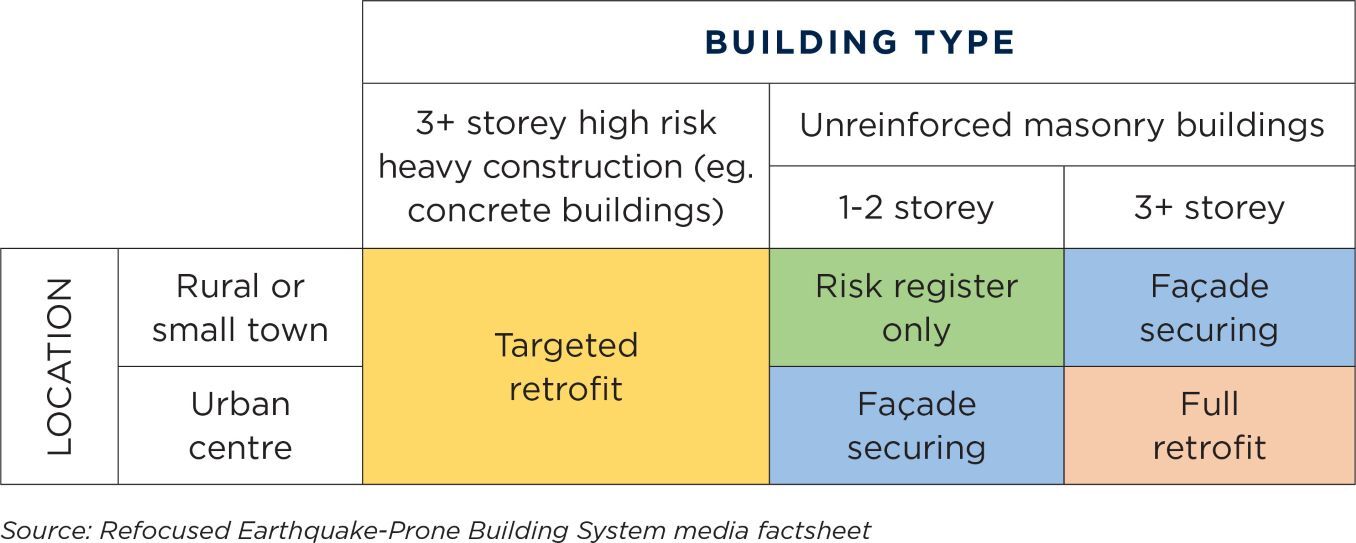Total Property -
Seismic policy shift

A new risk-based assessment system will shake up New Zealand’s approach to earthquake-prone buildings.
Building owners and industry groups have welcomed Government intentions to overhaul the earthquake-prone building (EPB) regime to focus on buildings that pose a substantive risk to human life, within identified seismic zones.
The current system requires all identified EPB buildings to be strengthened to at least 34 percent new building standard (NBS), regardless of geographical location, and with prescribed timelines for remediation or demolition.
Bayleys national director commercial and industrial, Ryan Johnson says this regime has proved to be unrealistic and cost-prohibitive in practice, and has impacted the long-term confidence of owners, tenants and investors.
“The rules as they stand have caused angst for affected commercial property owners, with many left without tenants and feeling hamstrung about how to move forward given the often significant costs and practicalities of remediation.
“Owners and investors have been frustrated with the current cumbersome, exaggerated-risk regulations, and the inconsistency of assessments and regulatory responsibilities over the past 15 years.
“The proposed new model is expected to remove more than half of EPBs – that’s circa-2,900 buildings – from the system completely, while other buildings will have more cost-effective remediation thresholds. Only around 80 buildings will require a complete retrofit due to the risk they present.
“This shifts the dial considerably, with the Government expecting savings of $8.2 billion in remediation and demolition costs as a result. The more pragmatic approach is also a gamechanger for the Auckland and Northland regions which will be removed from the EPB system, reflecting their low seismic risk.”

Risk-proportionate mitigation
Minister for Building and Construction, Chris Penk says refocusing the earthquake-prone building system to support thriving communities and the wider economy is a priority for the Government. He intends introducing the Building (Earthquake-prone Building System Reform) Amendment Bill by the end of 2025 and expects legislation to be passed in 2026.
While reducing safety risks for New Zealanders remains at the heart of the EPB system, Minister Penk says the proposed changes will focus mitigation requirements on the most vulnerable buildings that pose a genuine risk to life safety.
“Currently, all identified EPBs must be strengthened to at least 34 percent NBS. This blanket requirement often leads to high remediation costs and doesn’t take into account the building type or location.
“In many cases, the cost of remediation is simply unaffordable, and where a building owner lacks the sufficient financial reserves, the work cannot take place.
“The new EPB system takes a more targeted and risk-proportionate approach by focusing obligations on highly vulnerable buildings. Mitigation requirements for a building will depend on the building’s type and location, rather than achieving a percentage of NBS.
“For example, an unreinforced masonry building over three storeys’ high in a rural or small town may require façade securing, whereas the same type and size of building in a busier urban centre could require a full retrofit. Territorial authorities will determine which mitigation requirement applies to each EPB.”
Penk says the review of the EPB system was informed by a collection of externally procured research pieces, in combination with analysis undertaken by officials at the Ministry of Business, Innovation and Employment (MBIE). The review was also overseen by a steering group of experts in seismic engineering, property development and management, behavioral analysis, and resource management.
“New Zealand is a seismically active country. While we can never eliminate the risk of earthquakes, we can require action to strengthen earthquake-prone buildings in medium to high seismic hazard areas to reduce risk. The new tiered mitigation requirements will also support compliance, as they are more cost-effective and simpler for most building owners to meet.”
International best practice
The review of the EPB system found that New Zealand’s current approach to managing EPBs is relatively unique, with other countries not commonly placing mandatory remediation requirements on owners of private buildings.
“Our new approach incorporates features of successful programmes overseas such as enabling targeted retrofit (where suitable), not using earthquake ratings such as benchmarking against percentage of NBS to identify EPBs, retaining a seismic risk disclosure system (EPB Register) and penalties for non-compliance,” explains Penk.
Cabinet has also agreed to sharpen the coverage of the Health and Safety at Work Act 2015 (HSWA) so that if duty holders comply with relevant requirements under other legislation, like the Building Act 2004, to manage health and safety risk, the HSWA does not require a higher standard for the same risk. A bill to give effect to this and other decisions is being progressed, with officials at MBIE working with WorkSafe on guidance or other information to make clear how the two regimes interact.
Penk advises building owners and occupiers to seek legal advice around remediation responsibilities and commercial lease implications, but stresses that the current obligations on EPB owners to strengthen their buildings to 34 percent NBS (or demolish) by the set legislative deadline remain in place until an Amendment Act giving effect to the proposed changes comes into force.
“If a building is still defined as earthquake-prone under the new system, building owners will have a mitigation requirement. However, for many building owners, these requirements will be more cost-effective than their current obligation to strengthen the building to at least 34 percent NBS, and demolition will remain an alternative method of meeting mitigation requirements.
“Where there are contractual obligations that refer to a building’s earthquake-prone status or requirements under the current EPB system, for example in a lease agreement, the parties involved may wish to revisit these once the legislative changes take effect.
“However, even where there are no mandatory remediation requirements, there are benefits to remediating a building in addition to mitigating life safety risk, such as an improved ability to insure, tenant or sell the building and building resilience.”

Legal implications for building owners
Justin March, partner and head of real estate at legal firm DLA Piper New Zealand says the proposed new EPB system is positive, and should be embraced with that mindset by building owners and occupiers ahead of the Bill’s introduction to Parliament.
“Generally, our advice is to pause without putting yourself in material breach of any contractual or compliance obligations.
“Based on publicly available information about the replacement EPB system, I would say anticipate as much as possible whether your building is likely to be an EPB, and if so, start considering contingency plans.”
Building owners who have already committed to upgrade works because their building is currently an EPB under the NBS system, should review contractual commitments.
“The risk here is more contractual than regulatory, as we would expect Councils to be accommodating with their enforcement given the impending changes. Take advice on whether the new system can be integrated into those commitments and, if not, consider exploring the possibility of negotiating a pause until the details of the new system and legislation become clearer.”
Building owners who have undertaken or are in the process of remediating commercial buildings under the existing legislation, should not expect retrospective financial redress. March says implementing such measures would be highly challenging and likely unprincipled.
“However, the Government's early announcement of the impending changes is beneficial as it gives the market the opportunity to defer remediation decisions. Although this does not assist those already committed, there has been discussion about potential financial incentives moving forward, such as rates relief, bonds, grants, and depreciation for seismic retrofits, as well as possible Government investment.
“These measures essentially encourage remediation or mitigation and assist in softening the financial impact for building owners, and there are examples of these in other jurisdictions. However, we are not optimistic about an extensive incentive regime.”
Impact on commercial leases
In regards to commercial leases that make specific mention of NBS ratings, March says the starting position is that these clauses are contractually binding, regardless of the EPB system replacement, so variations to leases may be necessary to provide for the new regime.
“Much depends on the wording of these clauses as to whether a variation is required. For example, some leases will specifically refer to substituted or replacement seismic regimes and others contain generic catch-all provisions to account for changes in law or substitute legislation.
“Our observation is even if some existing lease provisions, particularly those that are well-drafted, capture the new EPB system, for a change that is as significant as a full replacement of the NBS, with new methodology, it would be prudent to vary the leases.
“As the new system is phased in, landlords and tenants will likely demonstrate maturity and be open to renegotiation. Most commercial leases that have comprehensive seismic NBS provisions are in a certain segment of the market with parties that are well-resourced and experienced – largely corporate or institutional landlords and corporate or Government occupiers.
“Insisting on provisions based on a regulatory regime that no longer applies, or an outdated engineering assessment methodology, would not make commercial sense.”
Health and safety obligations
As to how new EPB legislation will intersect with the HSWA, March explains that the current WorkSafe position is that if a person conducting a business or undertaking (PCBU) owns or occupies an EPB and meets the earthquake performance requirements of the Building Act, WorkSafe will not enforce a higher standard under the HSWA.
“This means EPBs are not automatically deemed imminently dangerous, and they can remain occupied while seismic remediation work is planned, funded, and undertaken. WorkSafe expects PCBUs to manage risks proactively, including those related to building parts, such as parapets and heavy ceilings.
“The proposed reforms aim to address ‘over-compliance’ by clarifying the boundaries between the HSWA and other regulatory systems, and the Government has stated that clear guidance will be made available to both building owners and occupiers.”
The devil is in the detail, says March and while information provided by MBIE has been helpful, it lacks specifics on the transition period and certain legislative aspects.
“One concern we have is although the replacement regime is a recalibration of the baseline for EPBs (which is necessary), market behaviour may still lead to owners and occupiers exceeding statutory minimums, if the new methodology permits, for competitive advantage.
“We have seen this with the present NBS rating regime, and we see it with Greenstar and NABERSNZ ratings, which are not compulsory. There is perceived value in having buildings that exceed the minimum in a highly competitive market to attract the best occupiers.
“For the new EPB system to work as intended, a change in attitude to seismic risk is required from a wide range of other key stakeholders such as financiers, insurers, and investors.”
Sector advocacy and support
Sector advocate Property Council New Zealand strongly lobbied that the current NBS-benchmarked system for EPBs was arbitrary, confusing, and disproportionate, leaving thousands of buildings empty and communities burdened with unfair costs.
Property Council chief executive, Leonie Freeman says Minister Penk’s proposal is a much-needed reset and she welcomes the new, practical framework that focuses on real risk.
“It is a commonsense approach to earthquake-prone buildings, still centred on preserving life, but targeting the buildings at most risk rather than a global one-size-fits-all policy.
The reason Wellington has so many empty buildings largely relates to the seismic issue and the uncertainty, and it’s a similar story in small town New Zealand where many public buildings have effectively been abandoned. Anything that brings better clarity to our sector around this massive issue is so critical and will keep communities safe and thriving.”
Freeman says early feedback from the sector has been very positive, and Property Council awaits further detail around heritage buildings and the interface with health and safety legislation in particular.
“Having certainty and clarity around the requirements is really important so people actually know what the rules are and what they have to do.”
